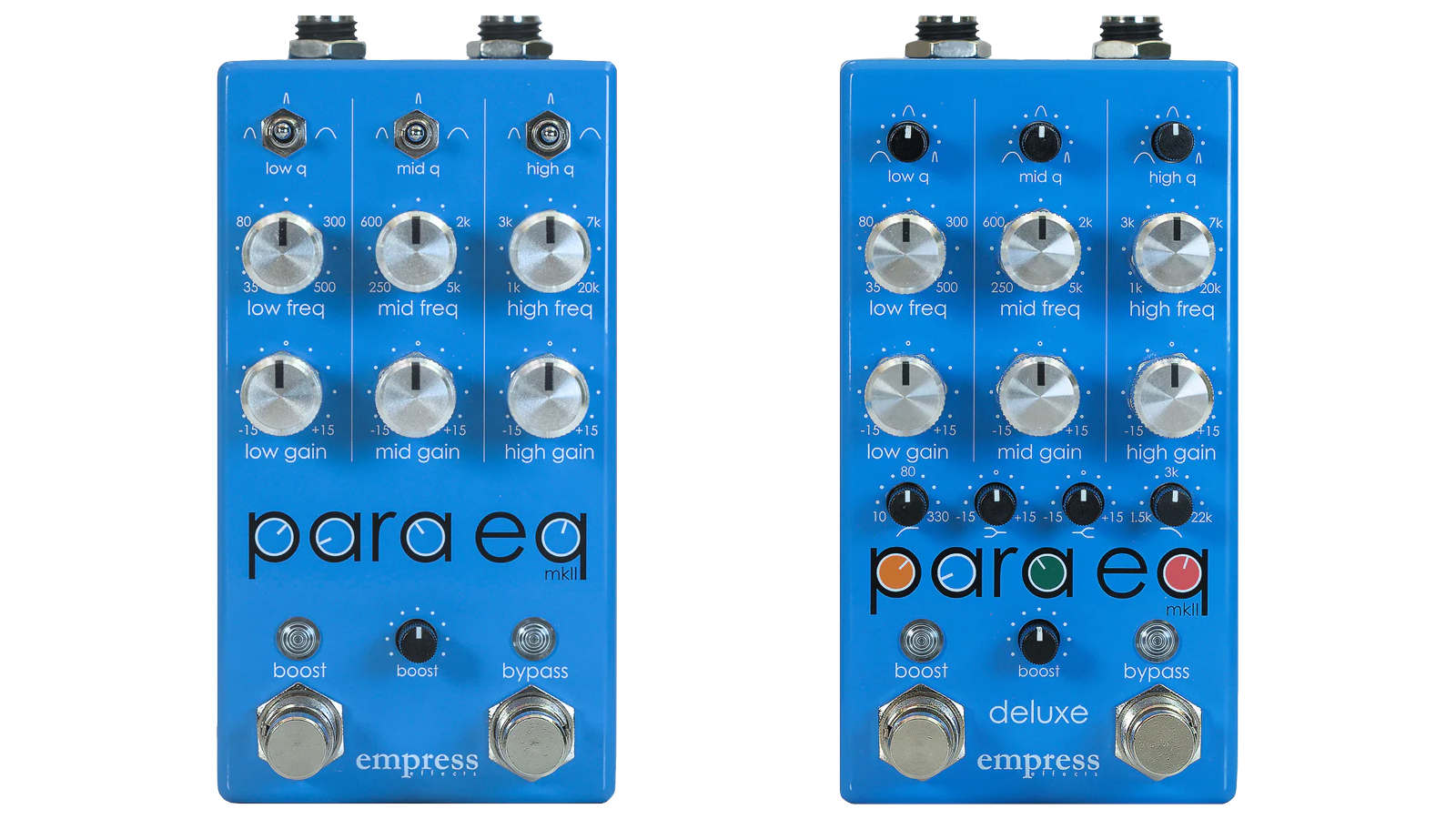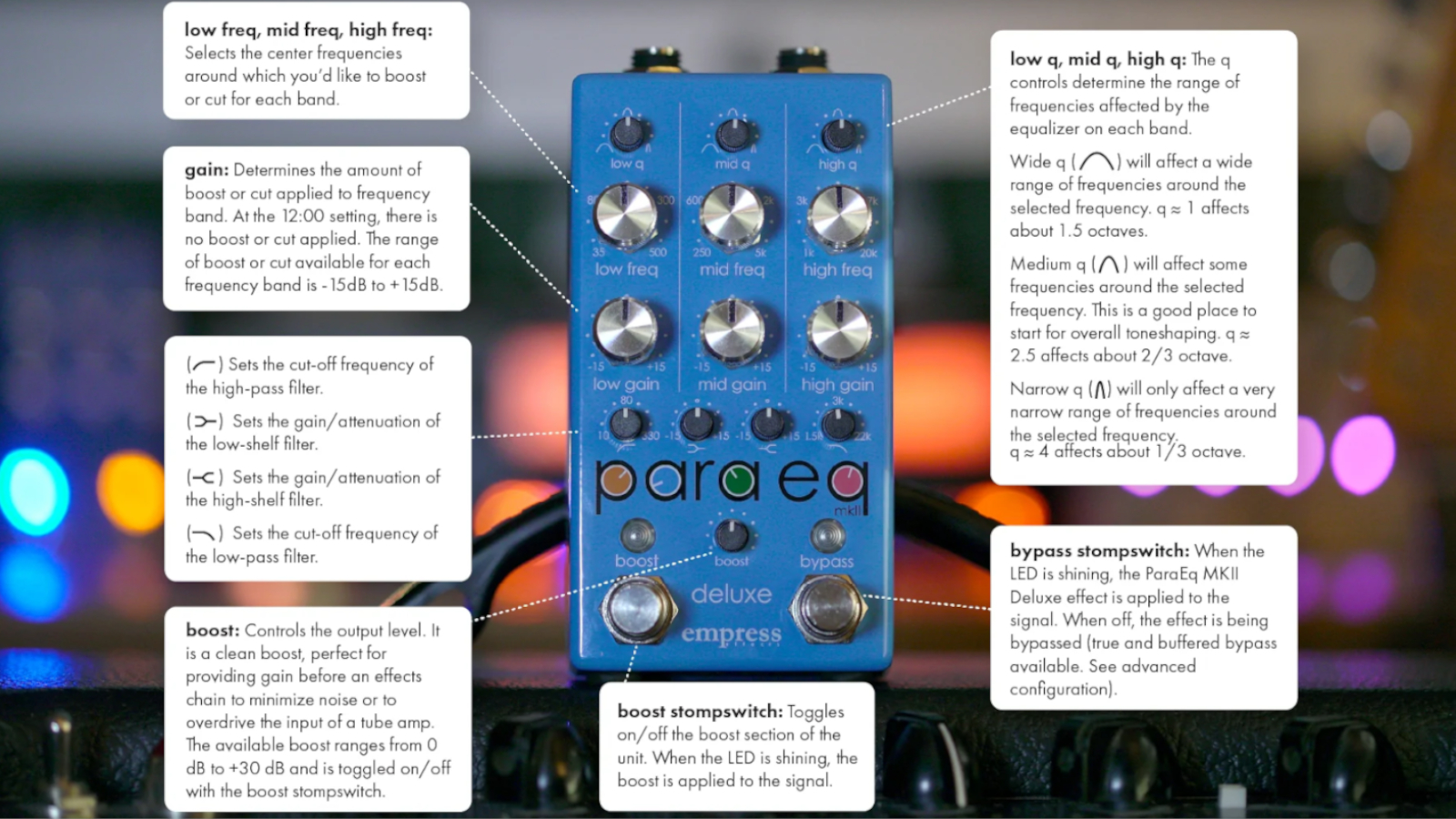"The Empress Effects ParaEq MKII Pedals Are as Good as It Gets": Head of Engineering, Jay Fee, Explains How Their New Parametric Equalizers Can Take Your Sound to the Next Level
The circuit designer himself tells us everything you need to know about Empress Effects' world-class EQs...

When the original ParaEq was discontinued, many questioned why. Prices immediately shot up and rumors abounded as to what was on the horizon.
Surely Empress Effects had good reason to cease production? Was it really the last of what those in the know had come to recognize as an industry standard? The end of a parametric EQ pedal with the enviable reputation as one of the best (if not, the best) in its class?
More Control. More Sweetness. More Power. More Purity.
Empress Effects
Fast forward to today and the Canadian firm is poised to start shipping orders of not one, but two versions of the ParaEq MKII. These latest iterations – the ParaEq MKII and ParaEq MKII Deluxe – appear in a smaller enclosure with a circuit designed from the bottom up.
So what’s different? In Empress Effects’ own words: “More Control. More Sweetness. More Power. More Purity.”
Knowing the immense benefits a high-quality EQ unit can bring to your sound, we spoke to Head of Engineering at Empress Effects, Jay Fee, about his new designs.
Here, we get to read the gospel of the Empress Effects ParaEq MKII pedals according to the circuit designer himself, as he explains what they can do for you as a guitar player.
Why is it important for guitarists to own an EQ pedal?
All the latest guitar news, interviews, lessons, reviews, deals and more, direct to your inbox!
EQ pedals can significantly extend the possibilities of all other equipment. They are more precise than most amp EQs and can be used in so many different ways, from broad tonal enhancement to surgical fixes.
A lot of guitarists use an EQ pedal to pre-shape the signal before an overdrive or to completely transform the sound of an amp. Some players might simply use them as a mid-boost for solos, while for others it might be a way of reducing the number of guitars they take on tour.
Graphic EQ is a bit of a shotgun approach, whereas parametric EQ is like using a sonic sniper rifle
Jay Fee
What’s the difference between graphic and parametric EQs?
Graphic EQ is a bit of a shotgun approach, whereas parametric EQ is like using a sonic sniper rifle.
The sliders on a graphic EQ are at fixed frequencies, so it’s rare you get to the perfect frequency. On a 10-band graphic EQ, each band is like an octave, so if you’re using a single band to reduce feedback, for example, you’re taking out a whole octave in the process.
However, a parametric EQ can center on the exact frequency and make narrower or broader cuts and boosts as needed.
What are the advantages of using a parametric Q control?
The adjustable Q control makes a big difference. In a situation where you want to correct or eliminate something, you can set a narrow Q.
When you want a broad sweetening (perhaps to enhance the low end, as a mid-boost, or to add some air to the top end) you can set a medium or wider Q, which tends to sound more transparent.
In other words, it still sounds like your instrument; it doesn’t change the character as much. If your goal is transparency, less is more.
Our goal with the ParaEq MKII pedals was to allow you to leave your original tone as intact as possible.
Our goal with the ParaEq MKII pedals was to allow you to leave your original tone as intact as possible
Jay Fee
Give us some tips on how to identify and treat problem frequencies using parametric EQ.
I recommend firstly overemphasizing it in your mind – latch on to the problem. Then create a boost in that area and sweep across until you can clearly identify where it lies in the frequency spectrum. From there, make a cut and adjust the Q as necessary.
It’s generally easier to sweep the boost across using a high Q setting so that you’re really locking on to the center point. Just to make sure, I recommend you A-B the sounds using the bypass function.
What unique effects can you get using parametric EQ?
You can get a really cool lo-fi effect by eliminating all the high and low frequencies. That’s sometimes used to contrast song sections, maybe to create a dramatic, open sound when the chorus kicks in, and take it back down in the verse or bridge.
In addition to creating natural-sounding mid-boosts for solos, you can go the other way and dial in really interesting Zappa-style cocked-wah sounds for prominent lead tones.
The metal mid-scoop is a really popular approach – taking out some of the mids while leaving or enhancing the bass and treble.
Also, guitarists are accustomed to reducing feedback by cutting frequencies, but a boost in certain frequencies can encourage feedback when that’s the desired effect.
EQ can make an instrument so much more versatile
Jay Fee
How might an EQ pedal affect the sound of a guitar’s pickups?
Many guitar players find they really like the sound of one pickup on a guitar, but another might benefit from some treatment. Maybe one pickup is too raunchy, the other isn’t raunchy enough, and what’s needed is something between the two.
These kinds of problems are really easy to fix with the Empress ParaEq MKII pedals because they give virtually infinite control.
Sometimes a guitar pickup might have too much low-end that needs to be tightened up before hitting your effects or amp. That can make a world of difference in terms of clarity, especially in a band mix.
It’s almost like getting a new guitar because the EQ can make an instrument so much more versatile.
Why is headroom important when it comes to parametric EQ?
You can run into trouble with headroom in parametric EQ circuits because you’re able to boost the signal level multiple times. The increased headroom was really important to avoid clipping and harmonic distortion.
The ParaEq MKII pedals required a complete change to the original design in order to improve this. They’re on par with rackmount equipment.
Although they are powered by a standard 9-volt DC connection, these pedals are running off 27 volts of headroom, which is triple that of a regular guitar pedal. We’re using a switching regulator to do that along with filtering to ensure very low noise and keep your sound as clean as possible.
We didn’t want ‘a sound’ with the ParaEq MKII pedals – we’re going for transparency
Jay Fee
What’s the difference between a cheap EQ pedal and the ParaEQ MKII pedals?
It’s about capabilities and features and the quality of components in the signal path. We use a high-quality switching regulator and low-noise op amps in the circuit, for example.
Sometimes people talk about ‘magical’ components that have a certain sound, but we didn’t want ‘a sound’ with the ParaEq MKII pedals – we’re going for transparency. In that sense, a lot of the magic is in the implementation.
The baxandall filter has long been used in Hi-Fi systems because it has such gentle EQ curves. This tends to lead to adjustments that are very musical and unassuming. We used transparent-sounding components that won’t color the sound and are always operating within their sweet zone.
What’s the difference between the two Empress ParaEq MKII pedals?
A lot of it comes down to the application and the type of user. The ParaEq MKII is ideal for sweetening tone or targeting problem frequencies.
Maybe you’re an acoustic guitar player and you just want to knock back some problem frequencies to control feedback. Or maybe you want to dial in a nice mid-boost for electric guitar. Either way, the regular ParaEq MKII is going to get the job done.
The MKII Deluxe offers the most control and versatility because of the added filters and sweepable Q. It’s the ultimate Swiss Army knife of tone.
For studio work and live performance, we believe the Empress Effects ParaEq MKII pedals are as good as it gets
Jay Fee
What notable players use an Empress Effects ParaEq MKII?
[Nashville session guitarist and producer] Tom Bukovac has used Empress Effects gear for years and we got in touch with him to see what he thought about the ParaEq MKII pedals because he’s a serious studio guy. We thought if we got his seal of approval, we’d be hitting the mark. A guitar player of that caliber is exactly where we’re aiming in terms of quality and performance, and he loves it - as does Paul Gilbert!
Aaron Marshall from Intervals is also using one. He created several launch videos to introduce the new pedals.
The ParaEq MKIIs are also very useful for bass players because of the added low shelf and high-pass filters. Both Tim Lefebvre [David Bowie, the Black Crowes, Elvis Costello] and Justin Meldal-Johnsen [Beck, St. Vincent, Nine Inch Nails] love them.
For studio work and live performance, we believe the Empress Effects ParaEq MKII pedals are as good as it gets.

Visit Empress Effects for more information.
Rod Brakes is a music journalist with an expertise in guitars. Having spent many years at the coalface as a guitar dealer and tech, Rod's more recent work as a writer covering artists, industry pros and gear includes contributions for leading publications and websites such as Guitarist, Total Guitar, Guitar World, Guitar Player and MusicRadar in addition to specialist music books, blogs and social media. He is also a lifelong musician.

